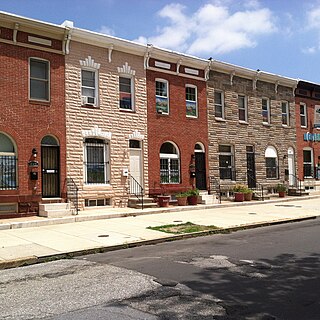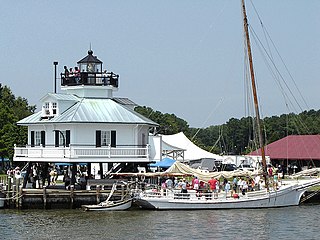
There are more than 1,500 properties and districts listed on the National Register of Historic Places in the U.S. State of Maryland. Each of the state's 23 counties and its one county-equivalent has at least 20 listings on the National Register.

Seton Hill Historic District is a historic district in Baltimore, Maryland. It was listed on the National Register of Historic Places in 1975.

Antrim 1844 Country House Hotel is a historic inn located in the heart of Taneytown, Carroll County, Maryland, United States. The Mansion is a 2 1⁄2-story Greek Revival style brick masonry house constructed in 1844. The property retains many of its outbuildings and is operated as a hotel and restaurant.

Davis-Warner House is a historic home located at 8114 Carroll Avenue, Takoma Park, Montgomery County, Maryland. It is a large, three story frame Queen Anne style residence constructed about 1875. It is one of the oldest residences in Takoma Park, and one of the only surviving Eastlake Stick Style examples left in the Washington D.C., area. It was built by John B. and Vorlinda Davis, who also operated a small store on nearby University Boulevard (then called "Old Bladensburg Road."

Johnson-Wolfe Farm, more commonly known as the Comus Inn, is a historic set of four buildings located at Comus, Montgomery County, Maryland. The complex includes a ca. 1862 vernacular dwelling known as the Comus Inn, smokehouse, and barn, and a ca. 1936 poultry house.

Temora, is a historic home located at Ellicott City, Howard County, Maryland. It is a T-shaped, two-story and cupola, Tuscan-style Victorian house of stuccoed tongue-and-groove boards. The house was built in 1857 after a design prepared by Nathan G. Starkweather, a little-known but accomplished architect from Oxford, England, who also designed the First Presbyterian Church and Manse at West Madison Street and Park Avenue in the Mount Vernon-Belvedere neighborhood in Baltimore, Maryland, with his later more famous assistant - Edmund G. Lind. The house was built for Dr. Arthur Pue Jr. on land given from his grandmother Mary Dorsey Pue of Belmont Estate.

Roberts Inn, is a historic home and farm located at Cooksville, Howard County, Maryland. The complex consists of a 2 1⁄2-story stuccoed stone house with a reconstructed log wing built about 1808, and several 19th- to early-20th-century agricultural outbuildings, including a frame bank barn, a frame ground barn, a tile dairy, and a frame silo. The construction of the house coincided with the extension of the National Pike through the Cooksville area. Documentary and architectural evidence supports its use as a turnpike tavern from an early date. Tradition holds that Marquis de Lafayette breakfasted at Roberts Inn during his 1824 tour of America.
The Old Colony Cove Site is an archaeological site near Rose Haven in Anne Arundel County, Maryland. The site consists of a shell midden and is 2,000 feet long by 300 feet wide.

The Rising Sun Inn is a historic home in Anne Arundel County, Maryland, United States. It is a mid- and late-18th-century 1 1⁄2-story frame house. The earlier section dates to about 1753 and is covered with a gable roof and features a brick gable end. In the late 18th century, a frame, one-room gambrel roof wing was added to the northwest gable end of the house. Since 1916, it has been used as the headquarters of the Ann Arundel Chapter of the Daughters of the American Revolution.
The Shawnee Old Fields Village Site, is an archaeological site near Oldtown in Allegany County, Maryland. The site contains Late Woodland and Contact period artifacts. An area between the site and the river's edge may be the location of a number of short-term camps and/or dwelling units. The first confirmed archeological manifestation of the several historically documented Shawnee villages in Maryland. It is believed to have been the home of King Opessa, a Shawnee leader.

The Inns on the National Road is a national historic district near Cumberland, Allegany County, Maryland. It originally consisted of 11 Maryland inns on the National Road and located in Allegany and Garrett counties. Those that remain stand as the physical remains of the almost-legendary hospitality offered on this well-traveled route to the west.

Tidewater Inn is a historic hotel in Easton, Talbot County, Maryland, United States. It is a Colonial Revival brick, hip-roofed, four-story hotel with flanking three-story wings and an addition on the north wing. The original section was completed in 1949, with an addition to the north constructed in 1953. The floor plan of the original building is a flattened chevron shape. It served as the preeminent hostelry and community gathering place on the Maryland Eastern Shore during the time when new automobile-oriented transportation routes intensified the volume of visitors.

Old Bloomfield is a historic home at Easton, Talbot County, Maryland, United States. It is a large and sprawling structure constructed in three major sections: a 1 1⁄2-story, three bay brick section with a steeply pitched roof built about 1720; a 1 1⁄2-story frame addition on the southwest gable built about 1840; and a 2-story frame wing on the southwest end of this earlier addition. Also on the property is a small frame dairy, a heavy timber-frame crib, and a barn. It has remained in the same family as a working farm continuously since the 17th century.

Brooklandville House, or the Valley Inn, is a historic restaurant and tavern building, and a former inn, located in Brooklandville, Baltimore County, Maryland. It is a 2 1⁄2-story stone structure facing the former railroad and dating from about 1832. It is associated with the Baltimore and Susquehanna Railroad, which crossed the property just to the south.

Half-Way House, also known as The Wiseburg Inn, is a historic inn and toll house located on York Road at Parkton, Baltimore County, Maryland. It is a large, 2 1⁄2-story Flemish bond brick structure. The main part, built as an inn about 1810, was placed in front of an earlier log structure which has since been used as a kitchen. The property includes three of the original outbuildings, a stone dairy, a stone laundry, and a board-and-batten shed / ice house. It was built to serve travelers on the newly opened turnpike from Baltimore to York. 4

Howard Park P.S. 218, also known as School 7, is a historic elementary school located at Baltimore, Maryland, United States. It is an early 20th-century brick school building located in the intact historic west Baltimore neighborhood of Howard Park. The earliest school building was constructed in 1908 and enlarged in 1913, 1936, and in 1957. The older sections are built of brick and accented with limestone details. It continued to function as a school until 1980.

Franklintown Historic District is a national historic district in Baltimore, Maryland, United States. It is the result of a plan developed in 1832 by William H. Freeman (1790-1863), a local politician and entrepreneur. His plan evolved gradually over the course of several decades and owes its success to his untiring promotion of the village. The central feature is an oval plan with radiating lots around a central wooded park. The district includes an old stone grist mill known as Franklin Mill, the innovative radiating oval plan, and the associated hotel and commercial area. The key residential buildings are excellent examples of the "I"-house form and display steeply pitched cross gables found in vernacular rural buildings throughout much of Maryland.

Reisterstown Historic District is a national historic district in Reisterstown, Baltimore County, Maryland, United States. Its development is inseparably identified with the roads that converge to form Main Street. They are Maryland Route 30 and Maryland Route 140. The earliest structures, including several of log, date to the late 18th century, although the town was founded in 1758. It developed as a convenient stopping place for weary travelers from the outer reaches of Western Maryland or Pennsylvania and many businesses catered to the traveler: including taverns and inns, smithshops, saddleries, stables, waggoners.

Charlestown Historic District is a national historic district at Charlestown, Cecil County, Maryland, United States. It consists of a 150-acre (0.61 km2) portion of the town containing all known existing 18th century features. There are 14 houses known to have been constructed during that century and its largest structures were the inns and hotels which served the popular Charlestown Fair in the colonial period.

East Monument Historic District is a national historic district in Baltimore, Maryland, United States. It is a large residential area with a commercial area located along East Monument Street. It comprises approximately 88 whole and partial blocks. The residential area is composed primarily of row-houses that were developed, beginning in the 1870s, as housing for Baltimore's growing Bohemian (Czech) immigrant community. Most of the homes in the district were created after older homes were demolished in order to make room for expansions to the Johns Hopkins Hospital. During the late 19th and early 20th centuries the neighborhood was the heart of the Bohemian community in Baltimore. The Bohemian National Parish of the Roman Catholic Church, St. Wenceslaus, is located in the neighborhood.






















